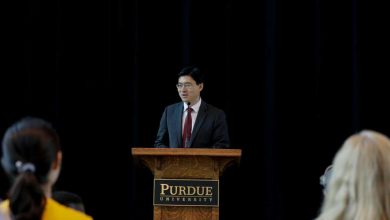New Carnegie Classification Will Reflect Social and Economic Mobility

For nearly 50 years, colleges have eagerly awaited the latest Carnegie classifications to find out where they fall in a pecking order that, to many, has become synonymous with prestige. The pinnacle is the coveted R1 ranking for colleges where robust teams of researchers reel in the most research bucks and train the most doctoral students.
Beginning in 2023, they’ll have a new distinction to aspire to: a category that reflects how well they contribute to social and economic mobility while serving diverse students.
The changes are being announced on Wednesday by the Carnegie Foundation for the Advancement of Teaching and the American Council on Education, which have joined forces to create a more inclusive classification system. The new system, they hope, will better reflect the diversity of higher-education institutions and create incentives for colleges to fill equity gaps.
Carnegie will retain ownership of the classification and will remain deeply involved when its home base shifts to ACE, in Washington, D.C., on March 15.
The classification was originally set to move from its current home, at Indiana University at Bloomington, to Albion College, in Michigan, but that plan was dropped last month.
The classifications, first published in 1973, were never intended as rankings or as markers of prestige, said Timothy Knowles, president of the Carnegie Foundation. They were a way to group similar institutions into categories so their work and impact could be compared. Those categories now include dozens of tiers of research, master’s, baccalaureate, associate, tribal, and other institutions.
But because America, and the world, loves rankings, “it turned into this race to the top, where the R1 became the designation that even institutions that really weren’t designed to be fundamentally research institutions began to aspire to,” Knowles said.
Reaching the top tier, or R1, has been a struggle for regional and minority-serving institutions that lack the resources and track record of obtaining big research grants. Among the 137 institutions classified as R1, for instance, none is a historically Black college.
“The opportunity to reimagine, rethink, and redesign the classification for the next 50 years is critically important,” Knowles said, “not just for the higher-education sector but for America and the economy.”
Colleges and universities need to reimagine themselves around inclusivity and student success, not selectivity and reputation.
ACE will use its position of influence to help shape policies that support the mobility goals, said its president, Ted Mitchell.
“We feel we have a unique perch from which to ask these questions about how the classification system can be more three-dimensional and more accurately reflect the wide diversity of institutions across the U.S.,” he said.
“We’re keenly interested in expanding recognition to those that create different lanes of excellence,” Mitchell added. That would include “institutions that are champions at racial equity and social and economic mobility but aren’t at the top of the research spending lists.”
‘A Place for Us’
The changes were welcomed by Miguel A. Cardona, the U.S. secretary of education. “Colleges and universities need to reimagine themselves around inclusivity and student success, not selectivity and reputation,” he said in a written statement. “I commend the Carnegie Foundation and the American Council on Education for their vision, and I hope today’s announcement will be the beginning of a new competition among colleges — one that rewards colleges doing the most for upward mobility.”
Cardona received his undergraduate degree from Central Connecticut State University, the kind of regional institution that is often overlooked in current ratings and rankings. The same is true of many minority-serving institutions like Howard University, where Vice President Kamala D. Harris earned her undergraduate degree.
You can’t punish institutions for not delivering people to high-salary-bearing careers.
It’s too early, Mitchell said, to list the metrics the foundation and association will use in determining which colleges provide the greatest mobility. They’ll be consulting with scholars and researchers who’ve been working to identify the most effective and equitable approaches to recognizing institutions that enroll large numbers of first-generation and other underrepresented students.
“It’s really important that, throughout this process, institutions feel they’re involved and this is something they can all buy into,” Mitchell said.
The new classification comes at a time when colleges are struggling to maintain their enrollments and growing numbers of students are questioning what kind of return they’ll get on their investment.
“Economic mobility has dropped precipitously over the past 50 years as Raj Chetty and others have shown,” Knowles said, citing the work of one of the nation’s pre-eminent researchers on the topic. “That isn’t the fault of higher education, but the higher-education ecosystem can play a central role in addressing it.” One way, he said, is to recognize and reward institutions that propel graduates forward.
There’s no shortage today of reports and scorecards trying to get a handle on which colleges do that best. Data from the Department of Education’s College Scorecard is regularly scrutinized for evidence of college affordability and bang for the buck. The think tank Third Way uses that data to determine how long it takes students to recoup college costs, based on how much more they’ll earn with a college degree. Washington Monthly rates colleges on what they do for social mobility and opportunities for public service.
Knowles cautions that attempts to measure colleges’ ROI can leave out important indicators of their benefits to society. “You can’t punish institutions for not delivering people to high-salary-bearing careers,” he said. “You have to be clear-eyed about the fact that the world does need a lot of social workers and teachers, and those careers often top out at very modest salaries.”
As the longtime leader of an HBCU that has resisted the pull of the R1 race, Michael J. Sorrell, president of Paul Quinn College, applauded the announcement. The current system of classifications, he said, creates incentives where “you have to become something different from who you were meant to be in order to be taken seriously or in order to get resources.”
Colleges where students start out on third base, he said, are rewarded when students make it to home plate. Colleges like his, where students might start out in the batter’s box, are held to the same standard. “There’s nothing about that that is right,” Sorrell said. “We’re just blessed to have a board that allowed us to create our own path.” Carnegie and ACE, he said, “are saying there’s a place for us.”
Shaun R. Harper, a professor of business and education and executive director of the University of Southern California’s Race and Equity Center, said he was “thrilled and grateful” for the change.
“The public doesn’t really care whether an institution is an R2 doctoral university with high research activity or a master’s university with medium-sized programs,” he said. “Instead, most prospective students and their families want to know whether a place is affordable and inclusive, and if it has a track record of delivering amazing postgraduation outcomes for Americans like them.”
Mildred García, president of the American Association of State Colleges and Universities, said the new classification would enable public colleges to benefit from the chance to be recognized for their success in creating better futures for underserved students.
Source link





